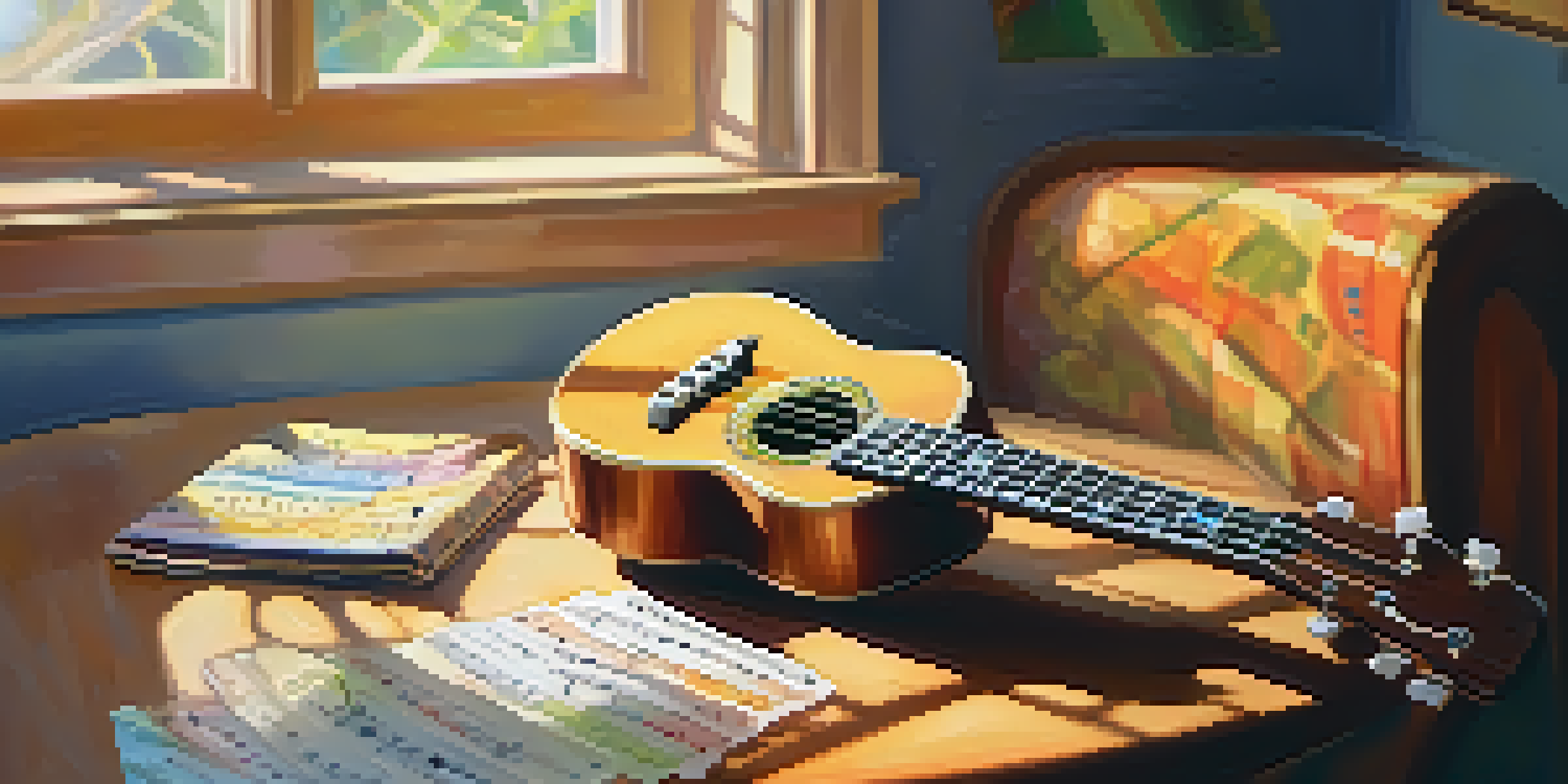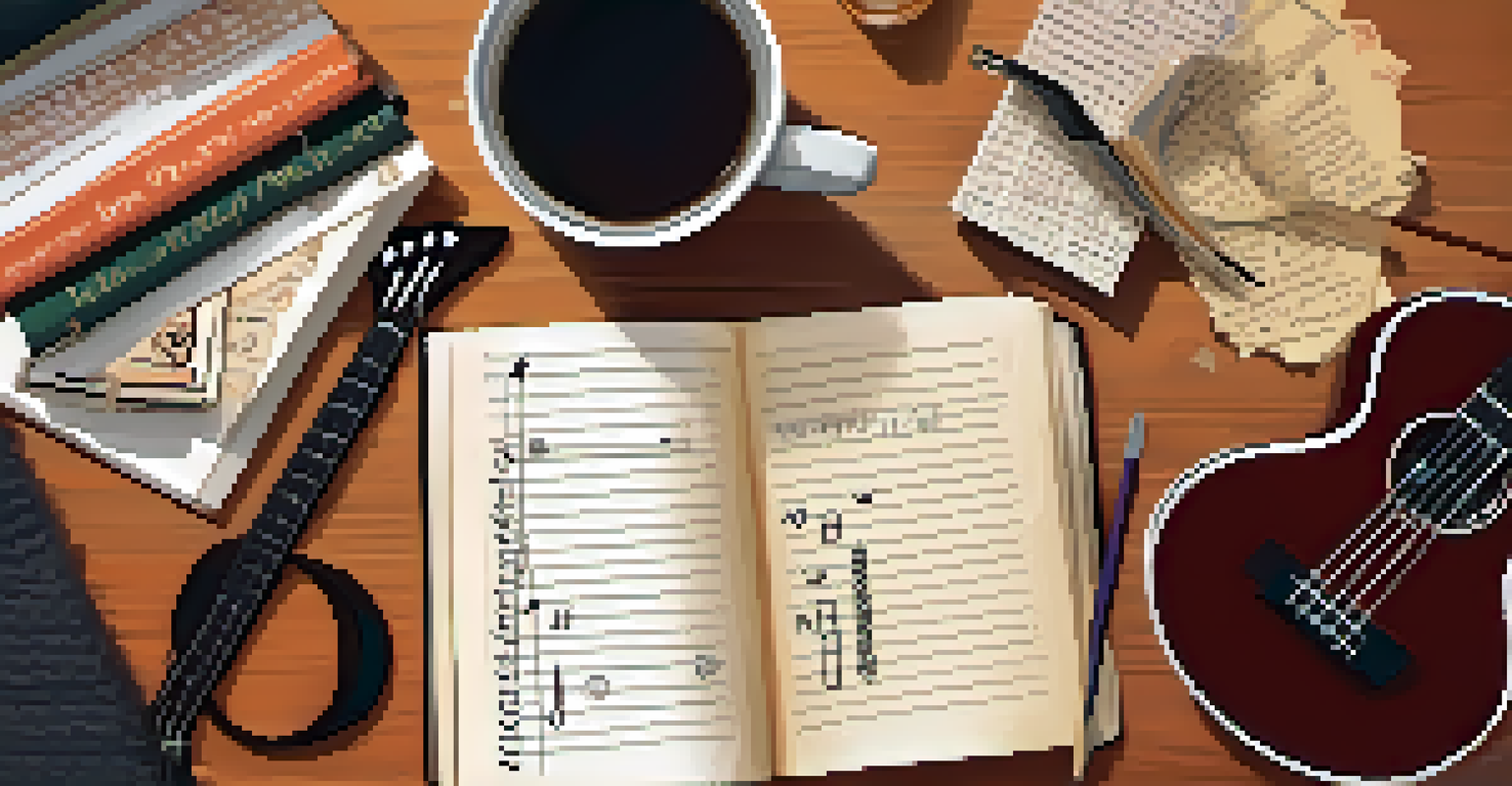Strumming Patterns for Beginners: A Guide to Ukulele Rhythm

Understanding Strumming Basics for Ukulele
Before diving into strumming patterns, let's understand the basics. Strumming is the rhythmic part of playing the ukulele, where you create sound by brushing the strings with your fingers or a pick. It's essential for keeping time and enhancing the overall feel of the music you play.
Music is the shorthand of emotion.
Think of strumming as the heartbeat of your song; it gives life to the notes you play. As a beginner, it's crucial to develop a steady rhythm and get comfortable with the motion of strumming. This foundational skill will serve you well as you progress in your ukulele journey.
Practicing strumming patterns can be as simple as tapping your foot to the beat while you strum along. This not only helps you keep time but also builds muscle memory, making it easier to learn more complex patterns later on.
Essential Strumming Techniques for Beginners
Now that you've grasped the basics, let's explore some essential strumming techniques. The most common methods include downstrokes, upstrokes, and a combination of both. A downstroke is when you strum down from the top string to the bottom, while an upstroke is the opposite, moving from the bottom to the top.

To practice these strokes, try using a metronome or a simple song you enjoy. Start slow, focusing on the evenness of your strums, and gradually increase your speed as you gain confidence. Remember, it's not about speed; it's about accuracy and rhythm.
Master Basic Strumming Techniques
Understanding downstrokes and upstrokes is essential for developing a solid foundation in ukulele strumming.
Incorporating finger patterns can also add variety to your playing. For instance, using your thumb for downstrokes and your index finger for upstrokes can help create a fuller sound and keep your strumming dynamic.
The Importance of Timing in Strumming Patterns
Timing is everything when it comes to strumming patterns. Think of it as the glue that holds your music together, ensuring each note and chord comes in at just the right moment. Practicing with a metronome can help you develop a sense of timing that will enhance your playing.
The beautiful thing about learning is that no one can take it away from you.
One useful tip is to count out loud as you play. For example, you might count '1 and 2 and 3 and 4' to keep track of the beats. This counting helps reinforce the rhythm in your mind and guides your strumming hand as you play.
As you become more comfortable, try playing along with recordings of your favorite songs. This practice not only improves your timing but also helps you learn how different strumming patterns fit into various musical styles.
Exploring Basic Strumming Patterns for Beginners
Now that you understand timing, let's explore some basic strumming patterns. A simple yet effective pattern is the 'D-DU-UDU' (down, down-up, up-down-up) rhythm. This pattern is versatile and can be applied to many popular songs, making it a fantastic starting point.
To practice this pattern, start slowly and focus on the motion of your wrist rather than your arm. This will help you maintain a relaxed grip and achieve a smoother strum. As you gain confidence, gradually increase your speed while keeping the rhythm steady.
Practice Timing with a Metronome
Using a metronome helps improve your sense of timing, ensuring your strumming patterns are rhythmically accurate.
Another great pattern to try is the 'D-D-D-D' (four downstrokes). This straightforward approach works well with slower songs and allows you to focus on chord changes without getting overwhelmed by complex rhythms.
Using Dynamics to Enhance Your Strumming Patterns
Dynamics refer to the volume and intensity of your playing, and they play a crucial role in creating engaging strumming patterns. By varying the strength of your strums, you can add emotion and depth to your music, making it more enjoyable for both you and your audience.
For instance, try strumming softly during the verses and increasing your intensity during the chorus. This contrast helps to build excitement and keeps listeners engaged. Remember, it's all about the feeling you want to convey through your music.
Experimenting with dynamics can also be a fun way to express your unique style. Don't be afraid to play around with different volumes—sometimes a gentle strum can evoke a sense of calm, while a powerful strum can bring energy and excitement.
Practicing Strumming Patterns Regularly
Consistency is key when it comes to mastering strumming patterns. Set aside time each day to practice, even if it's just for 10-15 minutes. Regular practice not only builds muscle memory but also reinforces your understanding of different patterns and techniques.
Incorporating a variety of songs into your practice routine can keep things interesting. Choose songs that utilize different strumming patterns, allowing you to apply what you've learned in a fun way. This will also help you connect with the music on a deeper level.
Explore Dynamics for Expression
Varying the volume and intensity of your strumming can add emotional depth to your music, making it more engaging.
Consider keeping a practice journal to track your progress. Jot down the patterns you've practiced, the songs you've played, and any challenges you've encountered. Reflecting on your journey can be encouraging and help you stay motivated.
Resources for Learning Ukulele Strumming Patterns
As you embark on your ukulele strumming journey, there are plenty of resources available to help you along the way. Online tutorials, YouTube channels, and apps dedicated to ukulele learning can provide valuable guidance and inspiration. These resources often include visual demonstrations, making it easier to grasp complex concepts.
Joining a ukulele community, either online or locally, can also be a great way to enhance your learning experience. Sharing tips, asking questions, and playing with others can motivate you to practice and improve your skills.

Lastly, don’t forget about books! Many instructional books focus specifically on strumming patterns and techniques for beginners. These can serve as excellent references as you develop your playing style and explore new patterns.